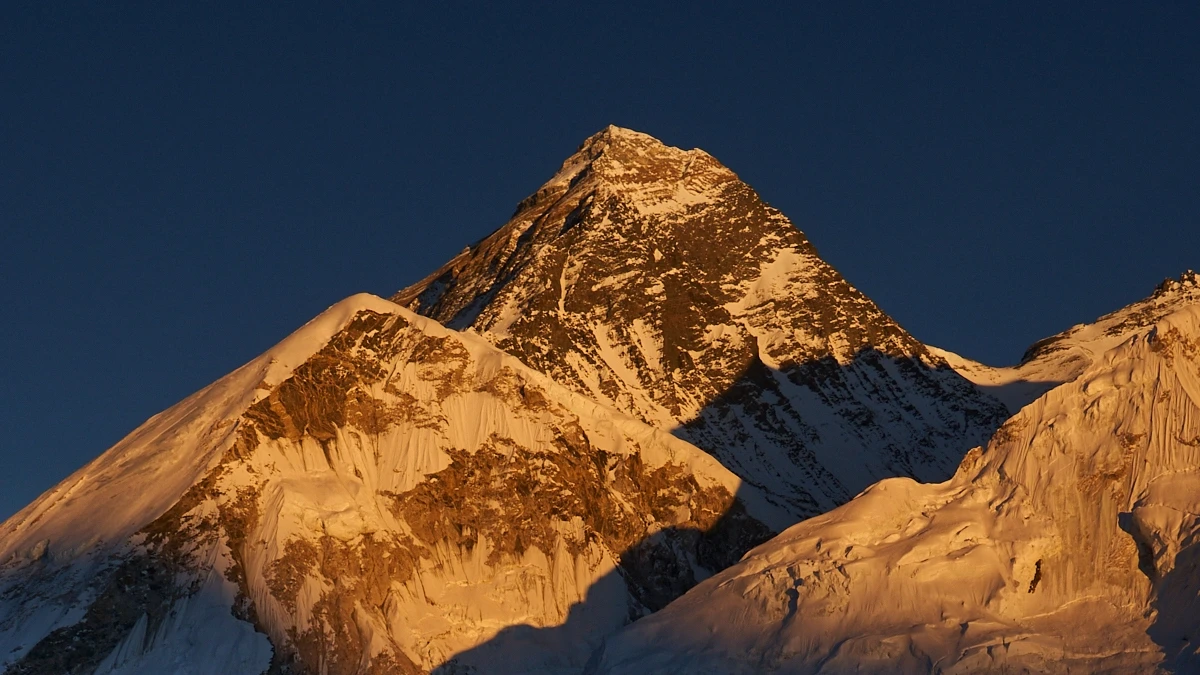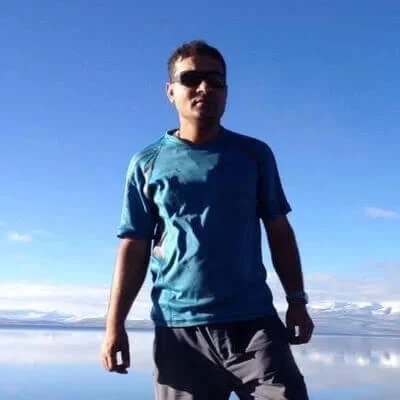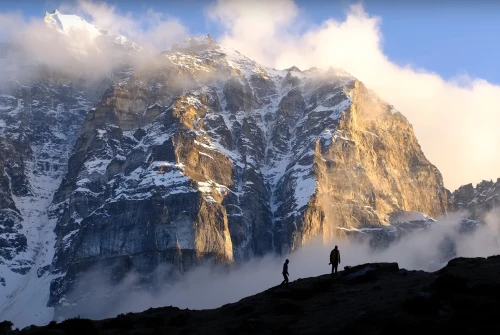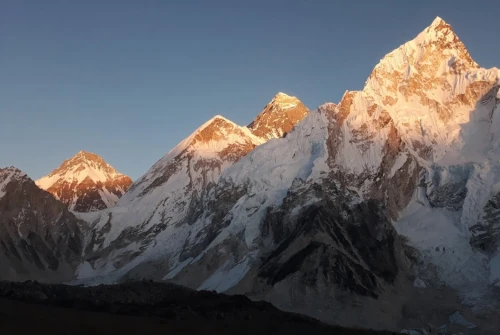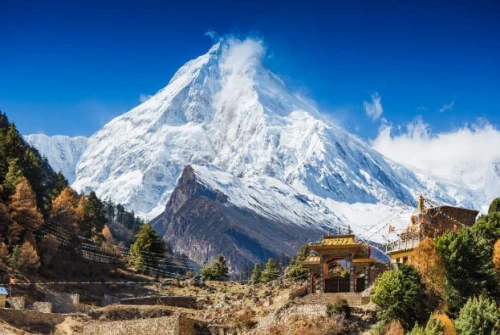What Is the Everest Base Camp Trek?
The Everest Base Camp trek is a world-renowned high-altitude hiking expedition that takes adventurers deep into the heart of the Nepalese Himalayas, leading them to the iconic Mount Everest Base Camp situated at an elevation of 5,364 meters (17,598 ft). Often referred to as the Nepal Everest Base Camp trek, EBC trek, or Mount Everest Base Camp hike, this journey offers a perfect mix of breathtaking natural beauty, cultural immersion, and physical challenge.
Typically lasting 12 to 14 days, the round-trip trek covers approximately 130 kilometers (81 miles), beginning from the mountain airstrip at Lukla. Trekkers navigate through lush valleys, ancient Sherpa villages, and rugged alpine terrain as they ascend towards Everest Base Camp, nestled below the towering peak of Mount Everest (8,848.86 meters / 29,031.7 ft) the world’s highest mountain.
One of the highlights of this adventure is passing through the Sagarmatha National Park, a UNESCO World Heritage Site known for its rare Himalayan flora and fauna, awe-inspiring glaciers, and towering peaks like Lhotse, Ama Dablam, and Nuptse. Trekkers also get the opportunity to visit culturally significant sites such as Tengboche Monastery and experience Sherpa hospitality in villages like Namche Bazaar, Dingboche, and Gorakshep.
Whether you're planning the classic Everest Base Camp trek 14 days, a luxury EBC trek with helicopter return, or exploring offbeat options like the Gokyo Lakes trek or Everest Three Passes Trek, this expedition is widely regarded as a bucket-list journey for adventure seekers across the globe.

How Long Is the Everest Base Camp Trek?
The Everest Base Camp trek duration typically spans 12 to 14 days, depending on your chosen itinerary, trekking pace, and time allocated for acclimatization. Most standard EBC trekking packages are designed for 14 days, which allows trekkers to gradually adjust to the high altitude and significantly reduces the risk of altitude sickness.
For those wondering, how long is the trek to Everest Base Camp? The round-trip journey covers approximately 130 kilometers (81 miles), starting and ending in Lukla. On average, you’ll spend 5 to 8 hours hiking per day, navigating through varied terrain ranging from forested trails and suspension bridges to steep, rocky ascents in the Himalayan alpine zone.
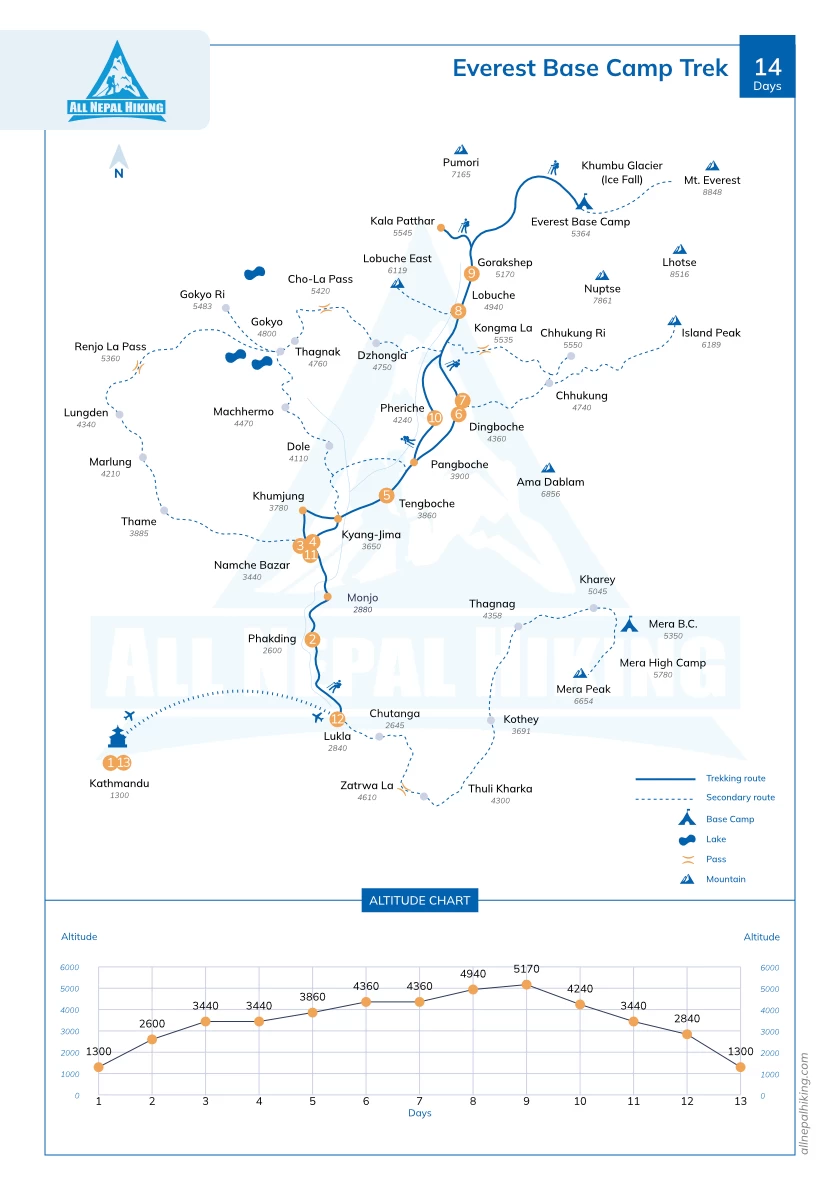
Shorter Trek Options:
- 10 Day Everest Base Camp Trek – Best suited for experienced hikers with good fitness levels. Includes fewer acclimatization stops and faster-paced trekking.
- 7 Day Everest Base Camp Trek – An intense itinerary with limited altitude adjustment. Often includes a helicopter return option to save time descending.
These shorter Everest Base Camp treks are not recommended for beginners, as they increase the likelihood of altitude-related challenges and require excellent physical conditioning.There are also longer alternatives, such as:
- Everest Base Camp via Gokyo Lakes trek (16 days)
- Everest Three Passes Trek (18 days)
- Everest Base Camp trek from Jiri (21+ days)
These extended routes combine EBC with other scenic and cultural highlights of the Khumbu region, offering more adventure for seasoned trekkers.
Everest Base Camp Trek Cost & Budget: What to Expect
One of the most frequently asked questions from aspiring trekkers is: “How much does the Everest Base Camp trek cost?” The Everest Base Camp trek cost can vary significantly based on your travel style, chosen itinerary, and level of comfort.
Average Everest Base Camp Trek Cost
- Budget Trek: $1,000 – $1,500
Ideal for independent or group trekkers who opt for teahouse accommodation, local guides or porters, and basic meals.
- Standard Trek Package: $1,500 – $2,000
Includes permits, domestic flights (Kathmandu–Lukla), accommodation, meals, a certified guide, and porters.
- Luxury Everest Base Camp Trek: $2,500 – $5,000+
Features high-end lodges with attached bathrooms, better food, personalized services, and optional helicopter return from EBC to Kathmandu.
Looking for a cheap Everest Base Camp trek? Choose a group package or book directly with local trekking companies in Nepal to minimize costs while still enjoying a guided experience.
What's Included in Most Trekking Packages?
Most EBC trek packages include:
- TIMS card & Sagarmatha National Park permit
- Round-trip flights to Lukla
- Accommodations in teahouses or lodges
- Daily meals (breakfast, lunch, dinner)
- English-speaking guide & porter services
- Emergency medical kit
- Some packages include Everest Base Camp helicopter tours or optional luxury upgrades
Packages labeled as Everest Base Camp budget treks may require you to pay separately for hot showers, Wi-Fi, snacks, and charging devices, which can add $5–$15 per day.
Hidden Costs to Consider
- Even if you book a budget Everest Base Camp trek, remember to budget for:
- Travel insurance (mandatory for high-altitude trekking)
- Gear rental or purchase (boots, down jackets, poles, etc.)
- Tips for guides and porters
- Extra snacks, drinks, or souvenirs
- Hotel stays in Kathmandu before and after the trek
When Is the Best Time for Everest Base Camp Trek?
The best time for Everest Base Camp trek is during the spring (March to May) and autumn (September to November) seasons, when the weather is stable, skies are clear, and the views of the Himalayas are truly breathtaking. These are the most popular months for trekking in the Mount Everest Base Camp region due to the ideal conditions and moderate temperatures.
In spring, the trails come alive with blooming rhododendrons and vibrant alpine flora, making it a perfect time for a Himalaya Base Camp trek or an EBC trek with routes like the Gokyo Lakes or Everest Three Passes trek. It’s also the Everest expedition season, so you’ll encounter climbers preparing for their summit bids at Mount Everest BC (Base Camp), adding a sense of excitement to the journey.
Autumn, especially from mid-September through early November, is widely regarded as the top season for trekking to Everest. Clear skies and mild temperatures offer stunning panoramas of Everest, Lhotse, Nuptse, and Ama Dablam. If you're planning your first Everest Base Camp trekking package, this is one of the safest and most scenic times to go.
While winter (December to February) is the coldest period, many experienced trekkers still enjoy the quieter trails and snow-covered Himalayan landscapes. Searching for Everest Base Camp trek December or Everest Base Camp hike in winter? It's a magical experience with fewer tourists, but be prepared for freezing temperatures and ensure you have proper cold-weather gear. Lodges may be limited, but the solitude is unmatched.
On the other hand, the monsoon season (June to August) brings heavy rainfall, cloud cover, and slippery trails. Trekking to Everest Base Camp during this time is not recommended due to the risk of landslides and flight delays. However, for seasoned trekkers seeking off-season adventure and lush green landscapes, it’s still possible with caution.
So, if you're wondering when to go for the Everest Base Camp hike, stick to spring and autumn for the best weather and trail conditions. Whether you’re planning a 14 days Everest Base Camp trekking, a luxury Everest Base Camp tour, or a budget EBC trek, the timing of your adventure plays a key role in your experience.
Preparing for the Everest Base Camp Trek
Proper preparation for the Everest Base Camp trek is essential to ensure a safe, enjoyable, and successful journey through the heart of the Himalayas. Whether you're embarking on a Mount Everest Base Camp trek, an EBC trekking package, or even a budget Everest Base Camp hike, being both physically and mentally ready can make all the difference.
One of the first steps is building your fitness for Everest Base Camp trek. Since you’ll be hiking for multiple days at high altitude, it’s crucial to start training for Everest Base Camp trek at least 8–12 weeks in advance. Focus on cardiovascular exercises like hiking, running, cycling, or stair climbing to improve endurance, and incorporate strength training for legs, back, and core muscles to help you handle the steep trails and carry your daypack.
Many trekkers also wonder how to prepare for Everest Base Camp trek or look for Everest Base Camp trek preparation tips. One of the most important aspects is gradual altitude acclimatization. You should plan to spend extra days at key elevations such as Namche Bazaar and Dingboche to allow your body time to adjust. Staying well-hydrated, eating nutritious meals, and avoiding alcohol during the trek can greatly reduce the risk of altitude sickness.
Your gear choices are equally important. Use a detailed Everest Base Camp trek packing list to make sure you're bringing the right equipment for the conditions. Key items include high-quality hiking boots, layered clothing for extreme temperature shifts, thermal wear, a good down jacket, a four-season sleeping bag, gloves, sunglasses, trekking poles, and a headlamp. Don’t forget essential accessories like water purification tablets, sunscreen, and blister care products.
If you’re traveling in the colder seasons or considering routes like the Everest Three Passes Trek, Mount Everest South Base Camp, or the Advanced Base Camp trek, extra cold-weather gear is critical. Pack smart and light but never skimp on essentials.
Mental preparation is just as vital. Long trekking days, changing weather, and altitude can be tough. Preparing yourself mentally by setting realistic expectations, staying flexible, and embracing the challenge can go a long way in making the journey more enjoyable.
No matter your route, be it the classic Everest Base Camp trail, Gokyo Lakes, or Mount Everest base camp via helicopter return thorough preparation is the foundation of a successful trek. Follow expert advice, train diligently, and pack wisely, and you’ll be ready to take on one of the world’s most iconic adventures: the Everest Base Camp trek.
Permits, Guides & Trekking Companies
Trekking to Everest Base Camp requires obtaining mandatory permits, including the Sagarmatha National Park Entry Permit and the Khumbu Pasang Lhamu Rural Municipality Permit. These are essential for anyone entering the protected Himalayan region and can be arranged either independently or through licensed trekking companies. If you’re planning the Everest Base Camp trek, it’s highly recommended to organize these permits in advance to avoid delays once you reach Lukla or Kathmandu.
Many trekkers choose to book a guided Everest Base Camp trek, especially first-timers or those unfamiliar with the challenges of high-altitude trekking. Having professional trekking guides ensures not only safety on the trail but also provides enriching insights into Sherpa culture, local traditions, and the natural wonders of the Mount Everest Base Camp trail. These experienced guides are well-versed in altitude acclimatization, first aid, and route navigation, making your trek smoother and more enjoyable.
Whether you prefer a solo Everest Base Camp trek, a group Everest Base Camp tour, or a private guided package, working with reputable Everest Base Camp trek companies adds significant value. They typically arrange all logistics, including permits, accommodations, domestic flights, meals, and even porter services. Some also offer customizable itineraries for routes like the EBC via Gokyo Lakes, the Everest Three Passes Trek, or an Advanced Base Camp trek.
For those looking for extra comfort and convenience, luxury Everest Base Camp trekking packages are available. These often include upgraded lodges with hot showers, hearty meals, and even a helicopter return from Everest Base Camp to Kathmandu ideal for those short on time or wanting to avoid the same return trail.
No matter your style, budget or luxury, solo or guided choosing the right company for your Everest Base Camp trekking package is crucial for a successful and memorable adventure.
Everest Base Camp Trek Difficulty & Safety
The Everest Base Camp trek is considered a moderate to challenging high-altitude adventure, demanding both physical fitness and mental determination. Many trekkers often ask, "How hard is the Everest Base Camp trek?" or search for terms like Everest Base Camp trek difficulty, especially if they’re new to trekking in the Himalayas. The trail involves long days of hiking (5–8 hours daily), rugged terrain, and gradual elevation gain, reaching up to 5,364 meters at base camp and 5,545 meters at Kala Patthar, the trek’s highest viewpoint.
Proper acclimatization is absolutely critical. Most itineraries are designed to include rest days at key altitudes such as Namche Bazaar and Dingboche to help your body adjust and reduce the risk of acute mountain sickness (AMS). Trekking slowly, staying well-hydrated, eating properly, and being attentive to your body's signals are the best ways to stay safe.
For added peace of mind, it's strongly advised to purchase Everest Base Camp trek insurance that covers high-altitude trekking and emergency helicopter evacuation. Reputable Everest Base Camp trekking companies will often require this before confirming your booking. While the trail is generally safe and well-traveled, having travel insurance ensures you're prepared for any unexpected medical issues or altitude-related emergencies.
Whether you’re tackling the classic Mount Everest Base Camp trek, the Three Passes trek, or a custom EBC itinerary, understanding the difficulty level and preparing for safety is key to having a successful and rewarding Himalayan experience.
Routes and Maps
The Everest Base Camp trek follows a legendary route that begins in Lukla and winds through iconic Sherpa villages such as Phakding, Namche Bazaar, Tengboche, Dingboche, and Gorakshep, ultimately reaching the EBC Base Camp at 5,364 meters. Along the way, trekkers are rewarded with breathtaking views of Mount Everest, Lhotse, Nuptse, and the striking Ama Dablam. This classic path is the most popular, offering a perfect balance of natural beauty, cultural encounters, and gradual altitude gain.
Using an Everest Base Camp trek map or a detailed EBC trekking map is highly recommended for planning your daily stages and understanding the elevation profile. These maps highlight rest stops, viewpoints like Kala Patthar, and altitude changes helping you prepare better for each day’s challenges.
For those seeking a more scenic and less crowded alternative, the Everest Base Camp trek via Gokyo Lakes is a fantastic option. This route includes the stunning turquoise lakes of Gokyo, the dramatic Cho La Pass, and unique vantage points of Mount Everest from Gokyo Ri. Though more challenging, this route merges with the traditional trail at Lobuche, allowing trekkers to complete the journey to base camp while experiencing more remote parts of the Himalaya base camp region.
No matter which path you choose, whether the basecamp Everest trek via Gokyo Lakes, the traditional Everest BC route, or even more advanced options like the Three Passes Trek, detailed maps and proper planning are key to a safe and fulfilling trek to Mount Everest Base Camp.
Cultural Insights & Sherpa Hospitality
One of the most enriching aspects of the Everest Base Camp trek is the opportunity to immerse yourself in the vibrant culture of the Sherpa people. Known globally for their unmatched mountaineering skills and resilience at high altitudes, the Sherpas are also deeply spiritual, welcoming, and proud custodians of their Himalayan heritage. As you journey through villages along the EBC Base Camp trail including Namche Bazaar, Khumjung, and Pangboche,you’ll witness daily life in the high Himalayas, where ancient customs still thrive.
Stops like the Tengboche Monastery, the spiritual heart of the Khumbu region, offer a chance to experience Buddhist rituals, prayer ceremonies, and even seasonal festivals. These sacred sites are not just cultural highlights but serve as tranquil resting points amid your challenging ascent. Visiting these places deepens your understanding of Sherpa values, such as harmony with nature, respect for the mountains, and devotion to community and faith.
Whether you're doing the Everest Base Camp trek 14 days, a short EBC trek, or combining the route with the Three Passes Trek, your interaction with Sherpa guides, local teahouse owners, and monks will leave lasting impressions. These cultural connections transform the trek to Mount Everest Base Camp from a physical challenge into a deeply human and spiritual experience.
Essential Tips for a Successful Everest Base Camp Trek
Preparing well and following some key tips can make your Everest Base Camp trek safer and more enjoyable:
- Hydration: Drinking plenty of water every day is crucial to help your body acclimatize to the high altitude. Aim to drink at least 3 to 4 liters daily during your trek to prevent dehydration and reduce the risk of altitude sickness.
- Altitude Sickness: Learn to recognize symptoms such as headaches, nausea, dizziness, and fatigue. If you experience any of these, it’s important to take rest days or descend if symptoms worsen. Proper acclimatization is essential on the EBC trek to ensure your safety.
- Local Guides: Hiring local guides not only supports the Sherpa community but also enhances your trek’s safety. Experienced guides know the terrain, can assist in emergencies, and provide valuable insights into the Himalaya Base Camp culture and environment.
- Packing: Layering your clothing is key to adapting to changing temperatures. Pack light but include essentials like thermal layers, a down jacket, sturdy hiking boots, and rain gear. For detailed advice, refer to the comprehensive Everest Base Camp trek packing list.
- Respect Nature: The Himalayas are a fragile ecosystem, so practicing Leave No Trace principles is vital. Dispose of waste properly, avoid disturbing wildlife, and minimize your environmental impact to preserve the beauty of Sagarmatha National Park for future trekkers.
Following these tips will help you make the most of your Mount Everest Base Camp trek while staying safe and respecting the local environment and culture.
Top 15 Frequently Asked Questions about Everest Base Camp Trek
Q1: Is the Everest Base Camp trek safe?
A1: Yes, with proper acclimatization, preparation, and a reputable guide, the trek is generally safe.
Q2: Can beginners do the Everest Base Camp trek?
A2: Yes, beginners can do the trek if they have good fitness and are willing to acclimatize properly. Consider beginner-friendly Everest Base Camp trek packages.
Q3: How much does the permit cost?
A3: The Sagarmatha National Park permit costs around $30 USD, and most trekking companies include this in their packages.
Q4: What’s the best way to get to the starting point?
A4: Most trekkers fly from Kathmandu to Lukla. Alternatively, some choose the longer Everest Base Camp trek from Jiri, which is a gradual and scenic route.
Q5: How long does the Everest Base Camp trek take?
A5: The classic trek typically takes 12 to 14 days, including acclimatization days.
Q6: What is the best time of year to do the Everest Base Camp trek?
A6: The best time is during spring (March to May) and autumn (September to November) for clear weather and moderate temperatures.
Q7: How difficult is the Everest Base Camp trek?
A7: It is rated moderate to challenging, requiring good physical fitness and proper acclimatization to handle the altitude.
Q8: What kind of accommodation is available on the trek?
A8: Accommodation consists mainly of tea houses and lodges, offering basic to comfortable rooms with meals included.
Q9: Do I need a guide for the trek?
A9: While not mandatory, hiring a local guide is highly recommended for safety, local knowledge, and supporting the community.
Q10: What gear should I bring for the trek?
A10: Essential gear includes layered clothing, a warm sleeping bag, sturdy hiking boots, a down jacket, and a good daypack. Refer to a detailed Everest Base Camp trek packing list.
Q11: Is there mobile or internet coverage on the trek?
A11: Mobile coverage is available in larger villages like Namche Bazaar and Lukla, and many lodges offer Wi-Fi for a fee.
Q12: What are the risks of altitude sickness?
A12: Altitude sickness is common at high elevations. Proper acclimatization, hydration, and rest days are vital to reduce risks.
Q13: Can I do the trek independently without a guide?
A13: Yes, but it is safer and more enjoyable with a guide, especially if you’re unfamiliar with the region or high-altitude trekking.
Q14: How much does the Everest Base Camp trek cost?
A14: Costs vary widely, but budget trekkers can expect around $1,000 to $2,000, while luxury packages can be significantly higher.
Q15: Are there any helicopter rescue options?
A15: Yes, helicopter evacuation services are available for emergencies, and some trekkers opt for helicopter return packages for convenience.
Final Thoughts
Whether you’re researching the Everest Base Camp trek for 2025 or searching for the best Everest Base Camp trek company, All Nepal Hiking is here to help you plan an unforgettable adventure. From the rich Sherpa culture to the breathtaking mountain views, trekking to Everest Base Camp is much more than a hike ,it’s a life-changing, transformative experience.
Start planning your Everest Base Camp trek itinerary today with All Nepal Hiking, and get ready for the adventure of a lifetime!
